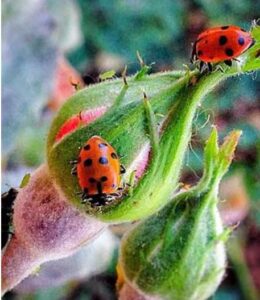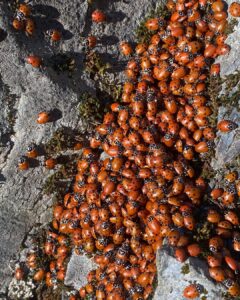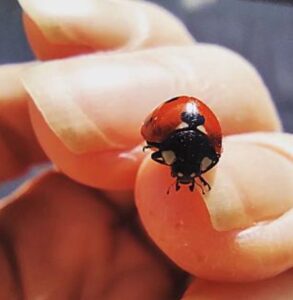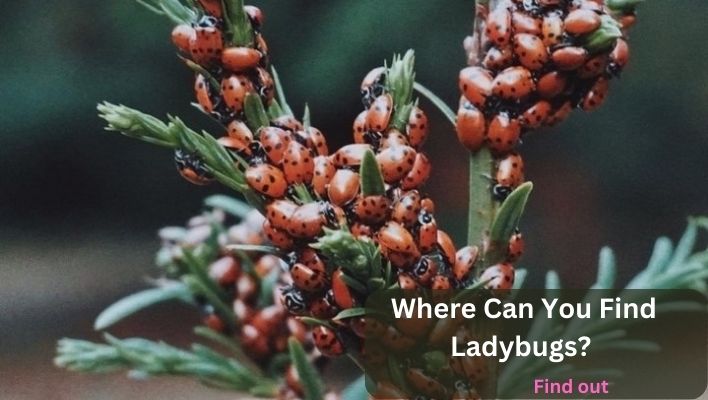Ladybugs, also known as lady beetles or ladybird beetles, are beneficial insects that many gardeners and nature enthusiasts welcome in their gardens. These insects are beneficial to have in your yard or garden, as they feed on various pests, including aphids, mites, and scale insects. But where exactly can you find ladybugs?
These small, colorful insects are known for their beneficial role in controlling pests and as a symbol of good luck. With their vibrant colors and cute appearance, ladybugs are popular in many gardens, parks, and meadows.
This article will provide a comprehensive guide on where to find ladybugs and how to attract them to your garden.
About Ladybugs
Ladybugs, also known as lady beetles or ladybird beetles, are a group of small, flying insects that belong to the family Coccinellidae. They are well-known for their round shape and vibrant red and black color pattern.
Ladybugs play a crucial role in maintaining ecological balance by feeding on aphids and other small insects that harm crops and gardens.
The life cycle of a ladybug starts with the laying of eggs by the female. The female will lay a cluster of yellow to orange eggs on the leaves of plants infested with aphids.
The eggs hatch in 3 to 5 days into larvae, which are small and have a dark-colored body with white spots. The larvae go through four molts, growing larger with each molt and feeding on aphids and other small insects.
After about 10 to 20 days, the larvae undergo metamorphosis and form a pupa. The pupa is immobile and will eventually turn into an adult ladybug.
The adult ladybug emerges from the pupa after a few days and is ready to mate and lay eggs. Ladybugs typically live for 2 to 3 years and can mate and lay eggs multiple times during their lifespan.
In the winter, some species of ladybugs will enter into a state of diapause, where they become inactive and conserve energy to survive the harsh winter conditions. During this time, they will find a suitable place to overwinter, such as a sheltered crevice or a warm, sunny spot.
Where to Find Ladybugs
Natural Habitats of Ladybugs
Ladybugs are found in many habitats, including meadows, fields, forests, and gardens. They are native to many parts of the world, including North America, Europe, and Asia.
Ladybugs prefer warm, sunny locations and are often found in areas with plenty of flowers and plants to feed on. They typically prefer areas with plenty of vegetation, where they can find food and shelter.
In their natural habitats, ladybugs feed on various insects, including aphids, mites, and other soft-bodied insects. Some common habitats for ladybugs include:
- Forests and Woodlands: Ladybugs are often found in forests and woodlands, where they can feed on aphids and other pests that infest trees and shrubs.
- Fields and Meadows: Ladybugs are also commonly found in fields and meadows, where they can feed on crops and other plants.
- Gardens and Landscaped Areas: Ladybugs are attracted to gardens and landscaped areas, where they can find a variety of food sources and shelter.
- On trees and shrubs
- In wooded areas
- Near water sources, such as streams and ponds

Attracting Ladybugs to Your Yard and Garden
If you want to attract ladybugs to your outdoor space, there are several steps you can take to make your yard and garden more appealing to these beneficial insects. Some tips for attracting ladybugs include:
- Planting a Variety of Flowers: Ladybugs are attracted to brightly colored flowers, especially those that are yellow, blue, or purple. Consider planting various flowers in your yard or garden to provide a food source for ladybugs.
- Providing Shelter: Ladybugs also need shelter to hide from predators and escape the elements. Consider planting bushes, shrubs, and trees in your yard to provide shelter for ladybugs.
- Reducing Pesticide Use: Ladybugs are important predators of pests, but insecticides can kill them. If you want to attract ladybugs to your yard, try to reduce your use of pesticides and other chemical controls.
- Water sources include a shallow dish filled with water and pebbles to help keep ladybugs hydrated.
Seasonal Migration Patterns
Many ladybugs are known for their seasonal migration patterns, which can impact where you can find them at different times of the year.
In spring and summer, ladybugs feed on aphids, mites, and other small insects that cause harm to crops. During this time, they tend to live in gardens, fields, and other agricultural lands. As winter approaches, the temperature drops, and food sources become scarce; ladybugs migrate to warmer regions in search of food and shelter.
Ladybugs typically migrate in large groups, sometimes reaching several million individuals in a single migration event. During their migration, they use various clues, such as the sun’s position and the wind direction, to navigate their way to their destination.
They can travel several miles in a day, flying in a specific direction until they reach their destination. The destination of ladybugs during migration is usually a warm, protected area where they can spend the winter without freezing.
They tend to seek shelter in caves, rocks, and buildings. In these areas, they huddle together to conserve heat and keep warm. However, during winter, some ladybugs enter a state of semi-hibernation, slowing their metabolism and reducing their activity.
For example, some ladybugs will migrate to warmer climates in the winter to avoid harsh weather conditions. Other ladybugs may migrate to areas with abundant food sources, such as fields with crops.
Ladybug Houses
Ladybug houses are a great way to shelter ladybugs in your garden. These structures can be purchased or built at home, providing a safe, dry place for ladybugs to rest and overwinter.
To attract ladybugs to your ladybug house, place it in a sunny, warm location and fill it with dry leaves or other organic material. You can also place a piece of fruit or a drop of honey inside the house to provide a food source.

Purchasing Ladybugs
If you want to introduce ladybugs to your garden immediately, you can purchase ladybugs from a garden center or online retailer.
When purchasing ladybugs, choose a reputable supplier and ensure that the ladybugs are collected from the wild and not bred in captivity.
Before releasing the ladybugs in your garden, place them in a cool, dark location for several hours to allow them to acclimate to their new environment.
Maintaining a Healthy Ladybug Population
Once you have attracted ladybugs to your garden, it is important to maintain a healthy population by providing a balanced diet and adequate shelter.
This can be achieved by planting a variety of flowering plants, providing water sources, and keeping the garden free of pesticides and other harmful chemicals. By providing the right conditions, you can help ensure a thriving population of ladybugs in your garden for years to come, which include:
- Create a habitat: Ladybugs need a place to live, and you can provide this by planting various plants that provide nectar, pollen, and shelter. Flowers like daisies, dandelions, and clover are ideal for attracting ladybugs. You can also provide shelter by planting shrubs or tall grasses.
- Provide food: Ladybugs feed on aphids, mites, and other soft-bodied pests, but they also need to eat nectar and pollen. Providing flowers blooming throughout the growing season can help sustain the ladybug population.
- Avoid pesticides: Pesticides kill both pests and beneficial insects like ladybugs. Instead, try using natural pest control methods like hand-picking pests or using companion planting to keep pests at bay.
- Provide water: Ladybugs need a source of water to survive. Provide a shallow dish filled with water and pebbles for them to drink from.
- Monitor population levels: If you notice a decline in the ladybug population, it may be due to a lack of food or habitat. Take steps to address these issues by planting more flowers, providing shelter, or reducing pesticide use.
Maintaining a healthy ladybug population is essential for preserving the balance of the ecosystem. By creating a habitat, providing food and water, avoiding pesticides, and monitoring population levels, you can ensure that ladybugs thrive in your garden or agricultural field.
Frequently Asked Questions About Ladybugs
Are ladybugs harmful to plants?
They are known for their ability to feed on various pests, such as aphids, mites, and scale insects that can damage plants. Ladybugs are considered an important ally to gardeners, as they help keep the plant population under control without using harmful chemicals.
However, it is important to note that while ladybugs are not harmful to plants, they can become a nuisance if they are found in large numbers. This is because they tend to cluster in certain areas, which can increase the amount of waste and dead bodies left behind. This, in turn, can lead to a decrease in the health of the plants.
Moreover, ladybugs can sometimes become predators and feed on other beneficial insects, such as bees and butterflies, which can harm the ecosystem’s delicate balance. In such cases, gardeners should reduce the population of ladybugs to prevent them from causing harm to other beneficial insects.

Are ladybugs poisonous to humans?
Ladybugs have a harmless and soft outer covering that protects their delicate body. They do not have any toxic or venomous properties that can cause harm to humans.
Ladybugs are not known to bite or sting and are generally considered harmless to humans. However, some people may experience an allergic reaction to ladybug bites or contact with their body fluids, but these instances are rare.
How can you tell the difference between male and female ladybugs?
The differences between male and female ladybugs are generally subtle and may vary depending on the species. However, some species of ladybugs have distinct differences in size or coloration that can be used to distinguish males from females. Here are some ways to tell the difference:
- Size: The female ladybug is generally larger than the male ladybug.
- Shape: The female ladybug has a rounder, more plump appearance, while the male has a narrower, more slender shape.
- Antennae: The male ladybug has thicker, more noticeable antennae that are club-shaped at the end, while the female’s antennae are thinner and more straight.
- Pronotum: The pronotum is the plate-like structure located between the ladybug’s head and wings. In males, the pronotum is narrow and has a pointed edge, while in females, it is wider and more rounded.
- Behavior: Male ladybugs are often seen flying around searching for a mate, while females are more likely to be seen resting on leaves or on the ground.
Observing the size, shape, antennae, pronotum, and behavior makes it easy to differentiate between male and female ladybugs. However, it is important to note that some species of ladybugs may have subtle differences, so it is essential to use a combination of these characteristics to determine the gender of the insect accurately.
Conclusion
Ladybugs are a wonderful addition to any garden and play a crucial role in controlling pests and maintaining a healthy ecosystem. You can attract and maintain a healthy population of ladybugs in your garden by providing the right conditions and habitat.
They are common in residential areas, especially near flowering plants and vegetables. Ladybugs can also be purchased from garden centers, online retailers, and mail-order suppliers.
Understanding their preferred habitats and food sources can attract and maintain a healthy population of ladybugs in your backyard. With their natural pest-fighting abilities, ladybugs are a valuable addition to any garden and provide a safe and effective way to keep your plants healthy and thriving.
